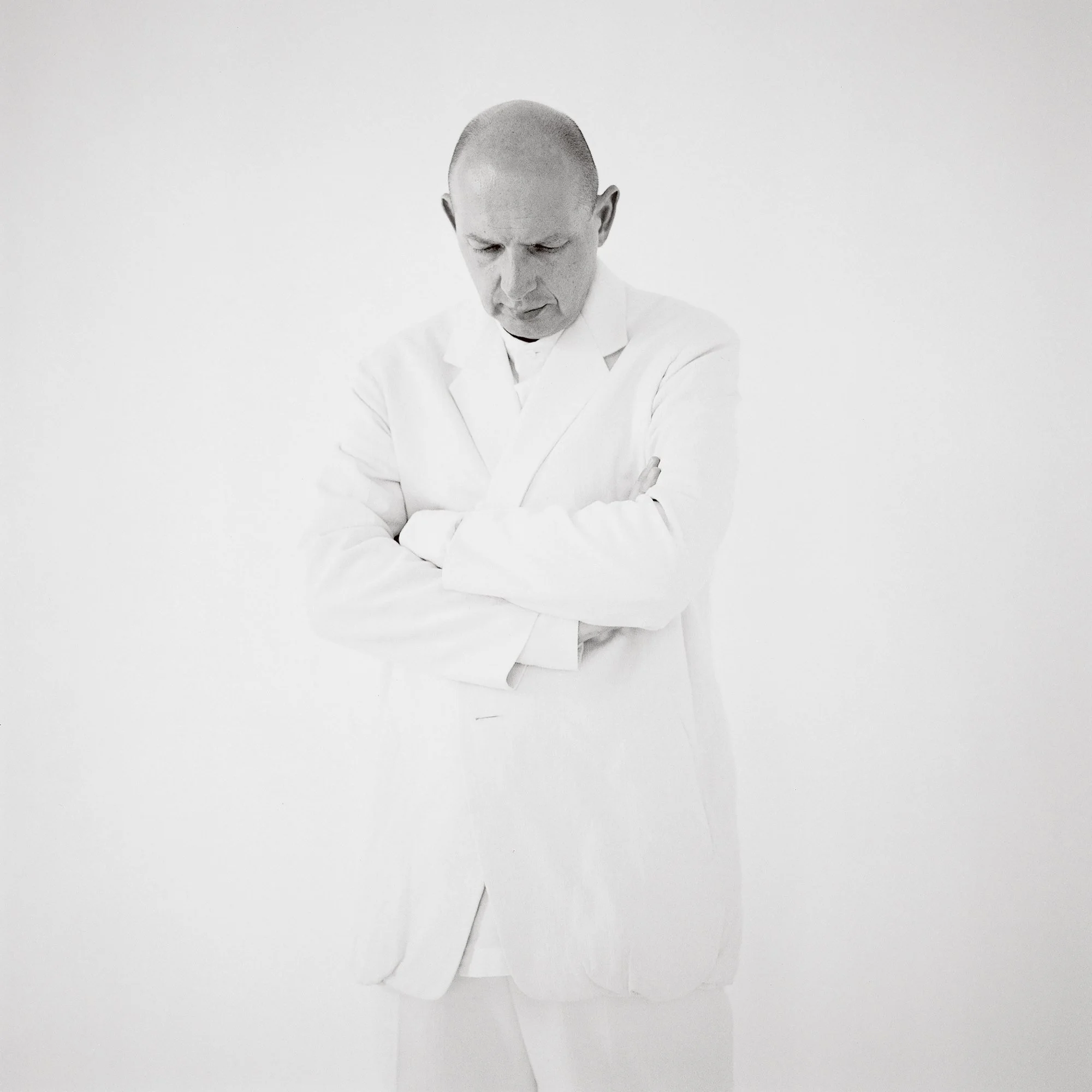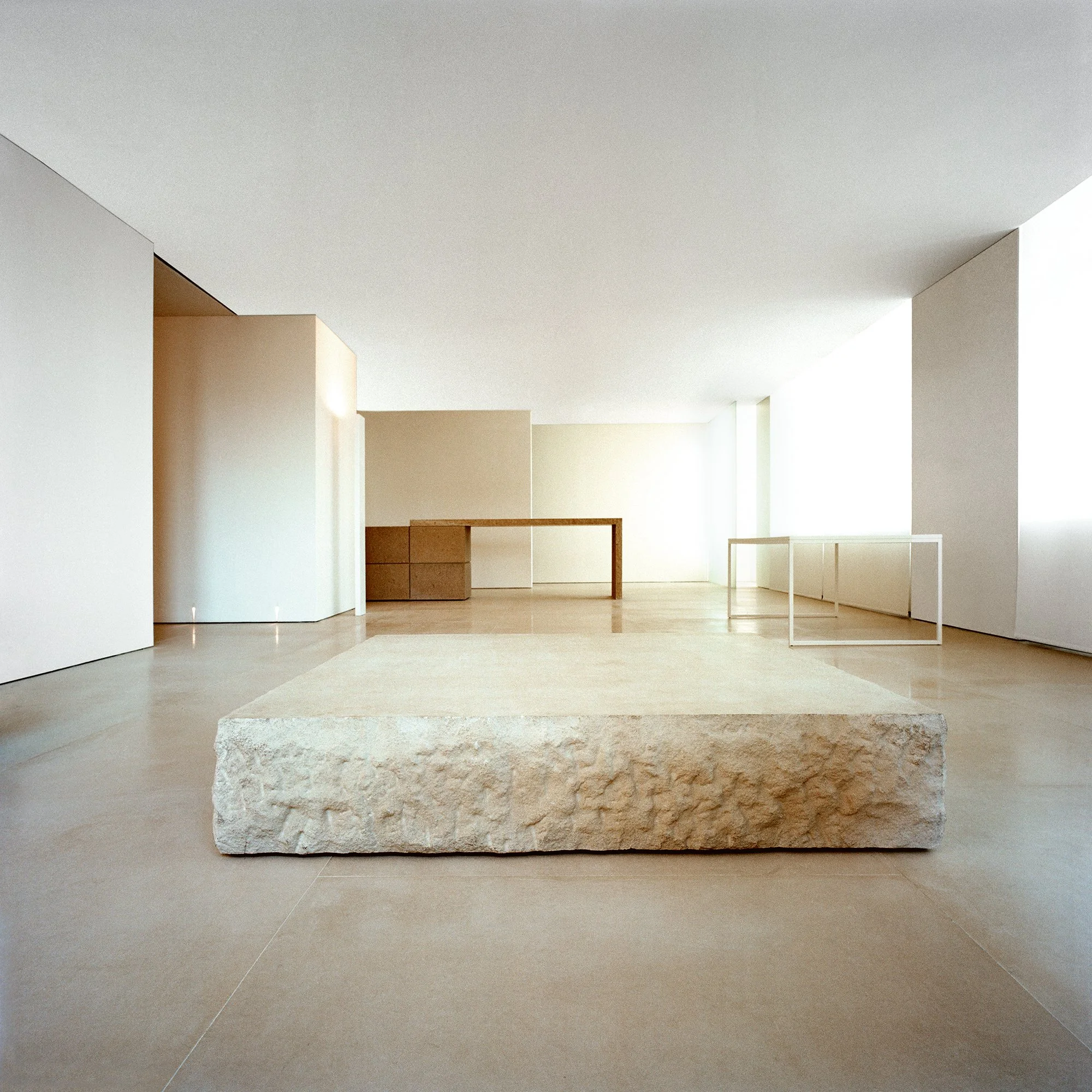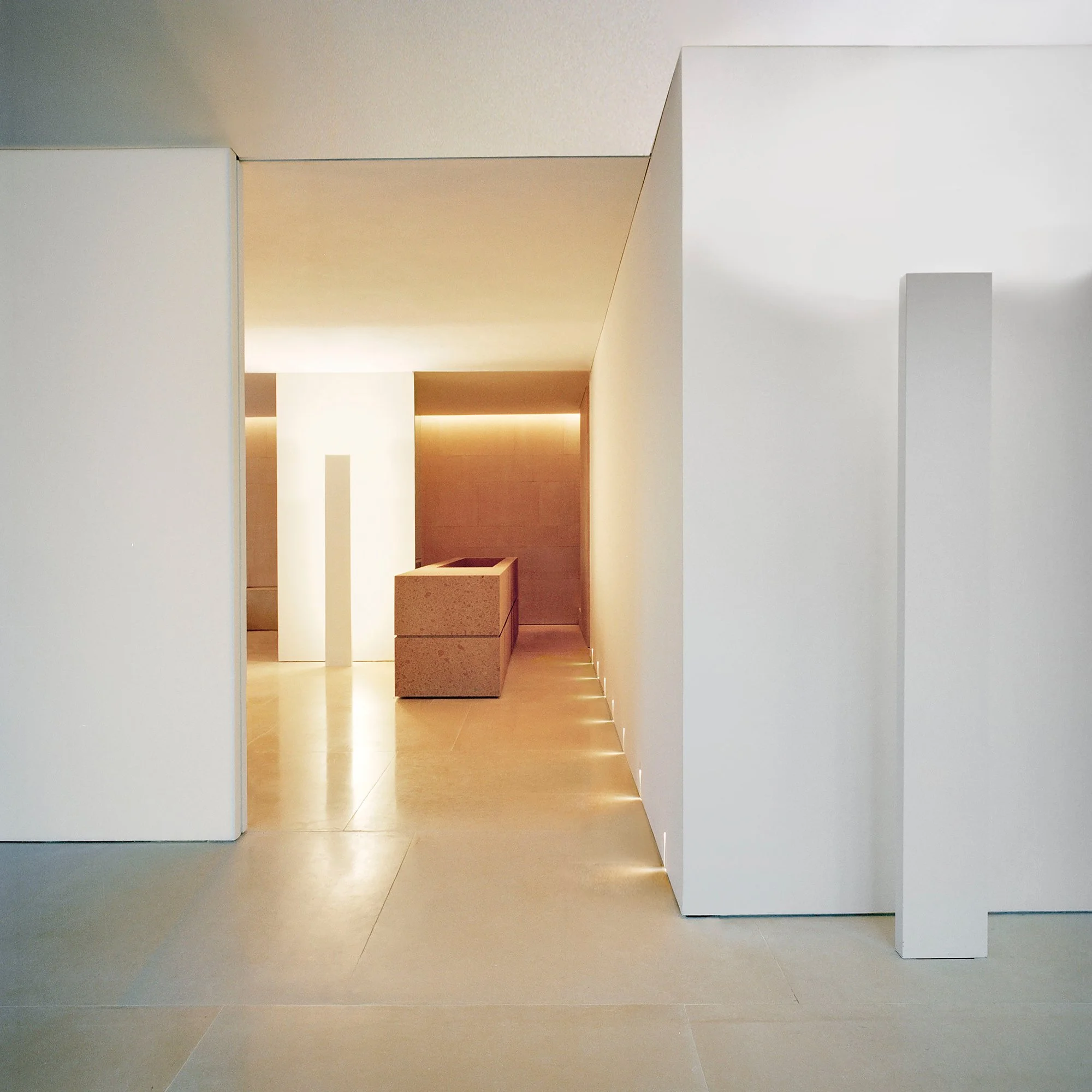Claudio Silvestrin
Interview by Katharina Korbjuhn
Portrait by Malena Mazza
Production
WHITELIES STUDIO
Itʼs almost impossible not to touch the big topics when talking to Claudio Silvestrin — they come naturally to the 66-year-old Italian born, London-based architect. Considered a master of contemporary minimalism, Claudio is admired by international architects and designers alike. Giorgio Armani, Terence Conran, and Kanye West are among his clients, the latter being his close collaborator for more than 20 years.
During our Zoom call at the end of a COVID-19 summer, his mind jumps on the hidden threads that connect the ephemeral, and before you know it: everything is architecture.
Kanye West Loft, New York
2007
© Marina Bolla
Katharina Korbjuhn: What does permanence mean in the digital age?
Claudio Silvestrin: Not everything should change. Itʼs very important to keep our DNA, so we can remain humans and not become machines. If we rely 100% on technology, we completely lose our divine self: Half man half machines.
KK: How do you think COVID-19 will impact our living space?
CS: We will give more importance to our homes. I suspect that we will have areas in our house dedicated to working and digital communication, specific furniture design for the work-from-home life.
KK: A recent New York Times article stated that the perfect work-from-home chair is yet to be invented.
CS: And possibly it will never be invented. The majority of chair designs are male-oriented. The body and posture of a female is very different from that of a male. So letʼs forget about the perfect chair. I use Mies van der Roheʼs Brno chair — from my point of view itʼs perfect. But who am I to say it is the perfect chair.
KK: Would you describe yourself as a minimalist?
CS: I like to think of myself without a category. I am me. One of my most important clients once told me: “You is you, this is why I come to you.” But if people call me a minimalist, it doesnʼt give me poison.
KK: What architects have influenced your style?
CS: Inevitably you get influenced by Le Corbusier, Mies van der Rohe, or Gropius. Van der Rohe has had the most decisive impact on my work, but this doesnʼt mean that I follow him religiously.
KK: Did your Italian roots shaped your work?
CS: If you look at minimal design and architecture from Northern countries, its colors are often grey, white, and black. Mine is much happier with natural colors, and I think this comes from the Italian background and the Renaissance in particular.
If you go to Bologna, all the houses are made of the same color as the earth, yellow okra, reddish, sienna brown. There is a warmness coming from the sun and the earth and the relationship of the two that you donʼt have in Northern countries.
KK: How would you describe your architecture?
CS: My aim is to do an architecture for the soul. You can see a temple in India or the Zen temples in Japan. They are very different, but if you feel the placeʼs soul, the vibrations are the same. I feel that I am a citizen of the planet — in fact, of the universe — not of a particular piece of land. This is how I want to build.
KK: An architecture understood by all…
CS: This is the great thing about geometry. A square is a square for everybody. A circle is a circle, no matter if you are in Japan, South America, or Germany. As soon as we color the square red or blue, we can have an opinion. Geometry is a universal language; itʼs not an opinion.
KK: How can architecture shape our behavior?
CS: I think itʼs a bit of an illusion. Most architects will say that I am crazy to say this. There is a tendency to see architecture as a doctor or therapy. To make the evolution of a personʼs soul, you need all aspects of their life. Life is rich, and architecture is just one slice of the cake.
KK: Have you ever built a house that is challenging for the people that live in it?
CS: I never did, and I never wish to. Itʼs quite the opposite. The client must feel in harmony with space. That is the only way it can touch your soul.
Kanye West Loft, New York
2007
© Marina Bolla
KK: What role plays spiritually in architecture?
CS: There is a difference between constructing a building and constructing architecture. Architecture has got an aura that is around the construction — therefore the conversation has to go into spiritual things, vibrations, etc. — otherwise, itʼs just concrete, mortar, and wood. Architecture goes beyond physicality. Spirituality is non-physical, you can feel it, but you cannot see it, it exists beyond choices of physical material and proportions.
KK: What project are you currently working on?
CS: I do a lot of work with Kanye West in Wyoming. I am also working on my first airport in Siberia, Russia.
KK: Do you work with images or words?
CS: A bit of both. Architecture surrounds us. It is not in front of us. So also, in communication, there is a totality. Space goes up to the galaxies — if you think in bricks and concrete, you are limited. Space is unlimited.
KK: How did the collaboration with Kanye start?
CS: About 20 years ago, when my first book was published, he saw it, opened it, fell in love with it, and telephoned me. A few weeks after we met, there was an interview in a music magazine and Kanyeʼs picture with my book saying it was his favorite thing of the year. That was nice.
KK: What do you talk about with Kanye?
CS: Itʼs an ongoing conversation for the last 16 years. With Kanye, I talk about proportions. Sacred geometry; knowledge of the past that has been hidden from the general conversation — whether on purpose or not.
KK: Why do you think that is?
CS: I think itʼs because all this deep knowledge doesnʼt help the growth of the economy. The “philosophy of the machine.” For the “aesthetic of the machine” to win, you have to forget about Palladio, Vitruvio and all these things, because they are the opposite of the machine.
When I read Vitruvioʼs Dei Architectura, I said to myself: “Forget it, Claudio, you can not be an architect. You learn that the architect must not only know sacred geometry; he has to know about astronomy and music, so many things that make your spirit immense.” Vitruvio put together knowledge that is easily 2.000-3.000 years old to stop it from disappearing. Today we dont learn about this architectural value and meaning anymore.
KK: Is there a project you always wanted to do?
CS: Yes. A cathedral — without compromises. The idea is that no religion is on top of each other: A universal cathedral.
KK: Maybe you have to do it in Wyoming?
CS: No. We are not allowed to do a church or a chapel in Wyoming, so that we might do it with a different name. But itʼs not straight forward because the people in power must allow you to do a church.
KK: Who are you going to ask for permission if itʼs a church for every religion?
CS: I donʼt worry about which religion or government. If it is, it is not for a specific country. Western society, or Eastern society. What about Northern and Southern society? They never get mentioned.
KK: Thatʼs how I feel about political parties. There is left and right, but what about the north and south wing?
CS: Exactly. Thatʼs the symbol of the cross: there are four, not just two directions. The original Christian cross had four equally long lines that pointed in all directions of the sky. Architecture is about deep knowledge — it is not all aesthetic and style. Today where everything is an opinion, there is no value in an opinion.



